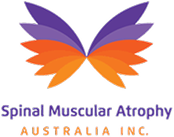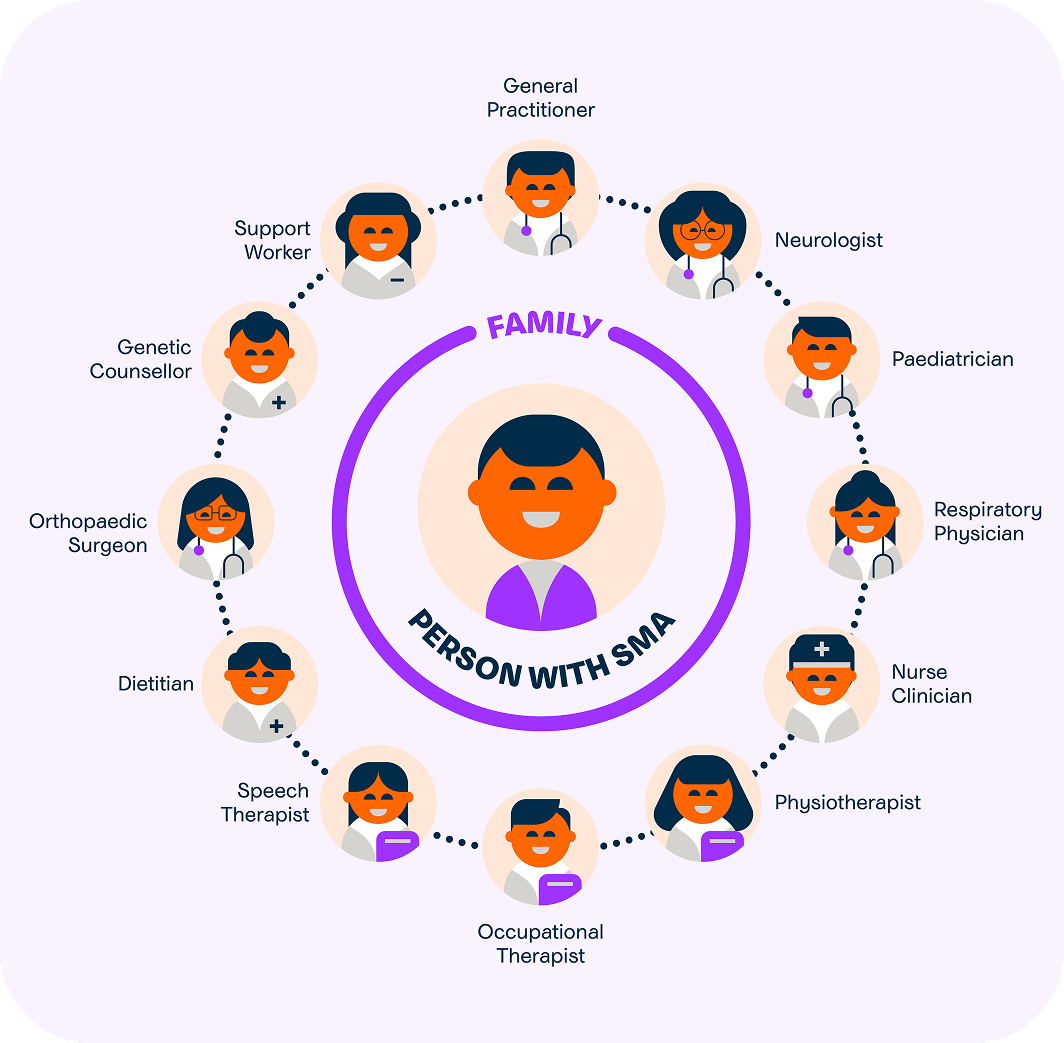
What is SMA?
Screening & Diagnosis
Living With SMA
Treatments
About Us
Contact Us
Back
If your teenager has just been diagnosed with SMA, you might have noticed some muscle weakness in their legs, hips, shoulders, arms or breathing muscles. They might have scoliosis, which is a curve in their spine. It can be great to finally have a name for all these symptoms, but a SMA diagnosis might also leave you and your child with lots of new questions.
SMA means your child’s muscles might get weaker over time, and they might need some extra help with things like walking as they get older.
Most importantly, SMA will not change their lifespan, and there is plenty of support available to help you and your child navigate living with SMA.
The kind of support your child will need will depend on how their SMA affects them, what treatment they receive and what your child’s multidisciplinary healthcare team, including their neurologist, recommend. They are the best people to help you find what is right for your child.
.jpg)

Taking care of your overall health is important when you have SMA. Some key areas to keep an eye on include:
Ask your healthcare professional for referrals to specialists who can help your child live a full life with SMA.
It is important to remember that, while your child’s healthcare professional team is best equipped to diagnose, manage and treat their condition, you are their greatest advocate and the one who knows them best. You should feel empowered to speak up, ask questions and ensure they are receiving the best possible care. Additionally, as they get older and begin to take on more responsibility for their own care, it is important to build their confidence in advocating for themselves. You can learn more about advocating for your child and teaching them to advocate here.


School
You might be wondering if SMA will change anything about your child’s life at high school, such as where they will go, how they will do their work and hanging out with their friends.
Most people with SMA go to regular schools, however, it is important that the high school your child attend has the right support available to set them up for success. This could be anything from ramps and elevators to make getting around easier, to having someone help your child take notes or tests if their hands get tired.
Starting high school is a big change for any child, but even more so when they have a disability. Just like when your child started primary school, the key is to plan ahead. Attending school open days and speaking to the principal, teachers, administrators and other parents, ideally while your child is in their final year of primary school, can provide valuable insights. Consider the school's physical layout (accessibility), their experience supporting students with disabilities, and the specific support they can offer for your child and do not hesitate to ask questions. You can also prepare a transition plan, arrange a student support group (SSG) meeting and prepare individual learning plans for your child.
The Raising Children website can help with this and offers valuable information and support for children with disabilities and their education.
For activities, such as sports, SMA might change how your child does things or how long they can participate. Your child’s physiotherapist can help your child figure out what’s possible and how to adapt so they can still do the things they love.
It is also important to remember SMA is a physical condition – it does not affect your child’s intelligence, and many people with SMA go on to attend university or pursue jobs they love.
Work
As your child’s friends start to get their first jobs, you might be wondering if SMA will make it harder for your child to find work. The good news is, there are plenty of jobs your child can do, even with some movement limitations, and plenty of employers who would love to have your child as part of their team.
Many high schools have teachers or career advisors who can help your child explore their options. There are also lots of online resources to help them find work, including programs your child can sign up for that will help them with resumes and interviews, and employers who are actively looking for people with disabilities.


Living with SMA might mean using different equipment and tools to help make things easier. Below are some common things your child might use:


Whether driving, flying or taking the bus, getting around with SMA may require some extra planning. Below are some things you may need to consider:
Travelling by Car
Access to suitable private transportation for your child can be helpful. This might involve using a wheelchair accessible vehicle to accommodate your child’s mobility needs. You may wish to own one, in which case you can apply for a disabled parking permit through your state or territory’s public transport website. Transportation services are also available to assist you. These include specialised services to transport people living with a disability, however, many rideshare services also have increasingly accessible options, such as the ability to book a wheelchair accessible vehicle. Your child’s healthcare professional can provide you with more information about available options and resources in your area.
If your child is able and interested in learning to drive, they may need access to a car that suits their needs. If they use mobility aids, they may need adaptations to help them drive a car, such as modifications to help them get in and out of the car or specialised aids and appliances such as hand controls. An OT can recommend vehicle modifications and equipment to suit their individual needs and help organise any specific driving training and assessments.
Accessing Public Transport
Australian public transport is held to disability standards to help ensure access is equitable. There may be some limitations, as these standards make assumptions about the dimensions, stability and manoeuvrability of your child’s mobility aids. As your child starts to use public transport by themselves, you may need to teach them the nuances of using public transport when you have a disability, such as how to request ramp assistance on a train or bus. Most operators also provide free or discounted passes. Visit your state or territory’s public transport website for further information on access and fares.
Flying with Your Child
Air travel requires some advance preparation, especially if your child uses a wheelchair. Here are some tips to ensure a smooth journey:



Your child’s General Practitioner (GP) plays a key role in coordinating their multidisciplinary healthcare team. Your GP is typically your first point of contact when pursuing a diagnosis for your child and can refer you to necessary specialists, such as a neurologist. Your GP will monitor your child’s condition on an ongoing basis.

A neurologist is often the first specialist you will be referred to if your child is showing symptoms of SMA or has been recently diagnosed. Your child’s neurologist will manage the diagnosis and treatment of your child’s SMA, and plays a key role in coordinating the multidisciplinary health team.

A paediatrician is a specialised medical professional skilled in identifying and managing a wide variety of childhood health conditions. Your child’s paediatrician will contribute to their ongoing care and monitor their development, which may be different to other children their age because of their SMA.

A respiratory physician monitors your child’s ability to breath effectively and will help address breathing problems that may result from their SMA. They can teach you and your child how to manage symptoms and assist with treatment if your child is exposed to a respiratory infection, to which they are more susceptible. These treatments might include medicines or specialised equipment for support.

Nurses in neuromuscular clinics are the primary experts and care coordinators for people living with SMA. They play a critical role in managing your child’s care plan, evaluating their health and monitoring their progress. They also provide advice, guidance and emotional support to you and your family, tailoring information to you and your child’s individual needs and challenges.

Allied health therapists, including physiotherapists, occupational therapists and speech therapists, can help your child preserve and adapt their fine and gross motor movements. They can also help you and your child with any adaptive technologies or modifications they may need, such as a wheelchair or installing ramps at home.

A dietitian can help you tailor your child’s diet to their individual needs and movement limitations. Helping to promote growth and motor function through nutrition is an important way to maximise muscle strength and minimise wasting.

Orthopaedic surgeons treat conditions affecting bones, joints, tendons and ligaments. You may be referred to an orthopaedic surgeon to help your child with scoliosis or impacts on their body resulting from muscle wasting, such as joint instability.

Genetic counsellors help people understand the likelihood of developing or passing on SMA, by providing access to genetic carrier screening, as well as support and guidance on family planning, and what this means for your extended family.



There are a range of support services available to people living with SMA, their carers and families.

A multidisciplinary healthcare team will support you or your child to live well with SMA. This should includes a General Practitioner (GP) and neurologist, and can also include specialists such as a respiratory physician, dietitian, orthopaedist, physical therapist (physiotherapist, occupational therapist or speech therapist) and genetic counsellor.

Home modifications might be required to accommodate someone living with SMA, such as widened doorways to accommodate a wheelchair, or ramps to assist those with reduced movement. Speak to your occupational therapist for more information.

Most students with disabilities attend regular classes in mainstream schools. Some students may need adjustments in these environments, or to attend support classes with fewer students who require similar accommodations. Depending on your child's individual needs, you might also consider a specialist school (public or private). For some children, a combination of specialist and mainstream schooling works well. Homeschooling or distance education are also possibilities to explore.

SMA Australia brings together a community of people living with SMA and their loved ones, to support people living with the condition through initiatives like peer-to-peer counselling, educate the wider public about the condition, and advocate for access to the best care and latest treatments.
This website is not intended to replace medical advice. Please speak to your healthcare professional for more information.
Join a powerful community of supporters who are helping tackle spinal muscular atrophy at its very core. Our community relies on us for support and best-practice resources to guide them in living well with SMA, as well as for resources to help raise disease awareness, educate others and advocate for people living with SMA in the wider Australian community.
